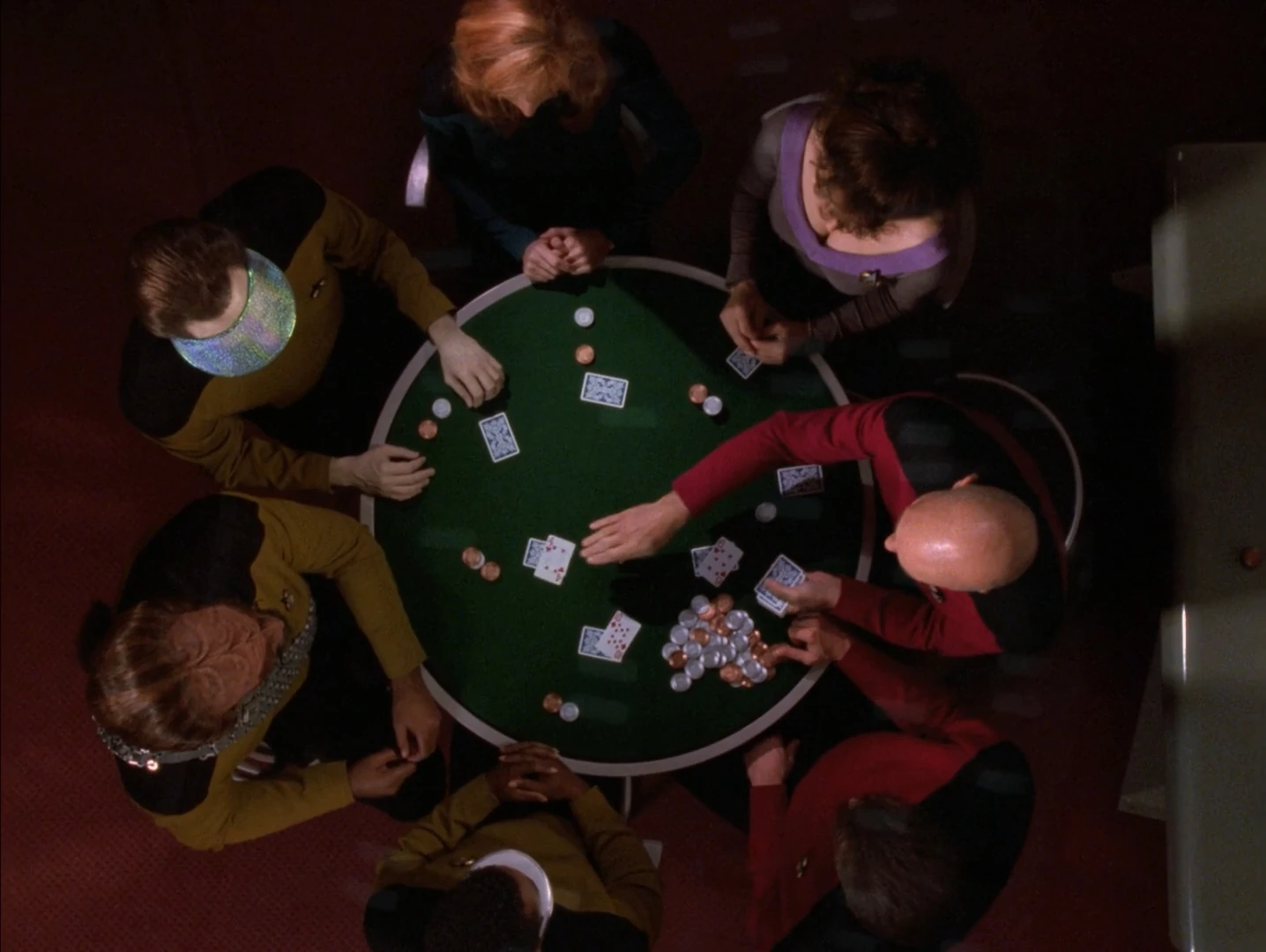One of the many things Star Trek fans like to debate is the preferred setting and time period (and parallel dimension) writers should use to tell stories within the Star Trek universe. While some fans love stories set in the gap years between installments we have already consumed, others would prefer the franchise leap into the future.
At the Vulture Festival in May, the now former Star Trek: Discovery co-showrunner Gretchen J. Berg said they “inherited the timeline” from the DSC’s creator and short-lived showrunner Bryan Fuller, but that she “loved the box” they were put in. She talked about how writers thrive when they are forced to operate within “boundaries and restrictions,” and how “overwhelming” it would have been to have to find a place for their show somewhere in the “entire universe” of Trek lore.
By stating that they “inherited the timeline” Berg is able to sidestep any debate about why the show is set ten years before the Original Series or whether that was a good idea. It is simply the reality of the show she was hired to write for. But it is clear that she appreciated Fuller’s choice of setting because, as a writer, it significantly reduced the amount of white space on the Blank Page CBS handed her.
As nature abhors a vacuum, writers abhor the Blank Page. Especially TV writers. There are too many disparate demands and studio “notes” dictating what their writing must accomplish, not to mention the relentless pressure of production and filming deadlines. The task of creating a new TV show–from concept, to production design, to characters (and casting), to filmable scripts–must be overwhelming in ways that fans of the show cannot appreciate.
Berg is not alone. Throughout the 52-year history of the franchise, many other Trek writers were similarly grateful that they did not have to reinvent their corner of the Trek universe from whole cloth. At every juncture, from the 1970s to the 2010s, Trek writers could have chosen any premise and any time period for their new Star Trek. What did they chose, and what do their choices tell us is likely to happen the next time Trek writers and producers are faced with the Blank Page.
Sample Size: Leaps vs. Gap Years
Let’s look at the numbers and define some terms. After TOS, the franchise has had 18 installments that reached either the development stage or filming stage. For our purposes, let’s define an installment as any time a studio gave writers and producers the green light to sit down with a blank sheet of paper and create a new Star Trek property for film or television.
The time period settings of these installments fall into three categories. The most common is a Continuation, when the series takes place soon after or simultaneous with a previous installment. Then there is the Gap Year, when a series is set somewhere in Trek’s past. The least common installment is the Leap, when the series takes place far in the future relative to previous installments.
- The Animated Series (TAS)–Continuation
- TOS Films–Continuation
- The Next Generation (TNG)–Leap
- TNG Films–Continuation
- Deep Space Nine (DS9)–Continuation
- Voyager (VOY)–Continuation
- Enterprise (ENT)–Gap Year
- Bad Robot Films–Gap Year
- Discovery (DSC)–Gap Year
Of the nine installments that were filmed and distributed–the six TV series and three film series–five were set in time periods that were Continuations of a prior installment. TAS presumably takes place during Kirk and crew’s original five-year mission, and the TOS Film Series beings some short number years after that. DS9 begins during TNG’s 6th season. The TNG Film Series and VOY begin within a year of TNG’s 7th season, when DS9 was in its 3rd season, and all three installments run concurrently with frequent character crossovers, visits to the same settings, and dual use of props and sets.
Three of the nine installments were set in Trek’s Gap Years. ENT takes place a century before Kirk’s five-year mission; the Bad Robot series begins during Kirk and Spock’s childhood; DSC takes place a decade before the five-year mission.
That leaves TNG, which takes place about 80 years after TOS, as the only Trek installment that represents a Leap into the franchise’s future. Therefore, when Trek writers were faced with the choice between the Blank Page and a familiar frame, they chose the familiar 89% of the time.
Choosing a Familiar Frame
Starting within a familiar frame exerts a powerful pull on the creative process, especially in sci-fi where the possibilities for every aspect of the show are limitless. When there are no limits, there are only infinite decisions the creators need to make. Decisions take time, energy and money to resolve. In TV and film, each decision faces the brutal math of production costs. Consider the benefits of some of Trek’s familiar frames.
When Michael Piller and Rick Berman set out to create DS9, they did not start with a Blank Page. Their premise of a space station at a stable wormhole between Bajor and Cardassia had already been developed and established over a handful of classic TNG episodes. Four of the seven lead characters had strong TNG ties: O’Brien had been on the 1701-D since TNG’s first episode; Kira was written as Ro Laren for much of DS9’s pre-production; Quark was a Ferengi, which was one of TNG’s original contributions to Trek’s pantheon of aliens; Sisko’s (and Jake’s) backstory was intricately tied to Picard. Similarly, VOY borrowed half of its premise–the Maquis crew–from storylines that had been developed on TNG and DS9.
Trek’s Gap Years are rife with opportunities for a familiar frame. Even before they wrote one script, the ENT writers knew from the start what a bulk of their stories would be: early interactions with the Klingons and Vulcans; the beginning of that TOS/TNG mode of exploration and familiar technology; the founding of the Federation.
All of these pre-existing plot threads and character elements offered the writers jumping off points and opportunities for creative synergy that would not be available to them if they had to dream up every element–new aliens, new locations, and new characters–from scratch.
Production design is another powerful motivator for showrunners to avoid the Blank Page. DS9’s alien station sets had to be designed from scratch, but their basic features and technology did not require radical rethinking of what we saw on TNG (holosuites instead of holodecks; ops instead of a bridge, etc). The Starfleet ships and tech on DS9 and VOY could be virtually identical to what the props department had in storage. All the ENT production designers had to do was smashkit the TOS Enterprise with circa 2000 nuclear subs and the International Space Station. With the Bad Robot movies and DSC, all there was to do was take TOS and TOS-Film era designs and update them with contemporary flourishes.
Premise, setting, production design are all things that must be sweated out before the first scripts can be written. Choosing a familiar frame that is a Continuation or set in a Gap Year makes the process less daunting and, since millions of dollars are on the line, much less stressful for the showrunners.
The Undeveloped Treks
We see the same trend if we expand our sample size to Trek installments that achieved some development but never reached the production or filming phase. There are nine of these scattered throughout the franchise’s history. All but the last two listed below are archived as “undeveloped” on Memory Alpha:
- Planet of the Titans–Continuation
- Phase II–Continuation
- The First Adventure (Starfleet Academy)–Gap Year
- IMAX–Continuation
- The Beginning–Gap Year
- Federation–Leap
- Final Frontier–Leap
- The CBS Meyer Trilogy–Gap Year
- The CBS Picard Series–Continuation
Four of these are Continuations. Planet of the Titans was to be the first motion picture with the TOS crew; Phase II was to be a TV series with most of the TOS crew, set on a refit Enterprise a few years after the first five-year mission; the 1990’s IMAX project would have focused on O’Brien and likely been set in the TNG/DS9 timeframe; the new Picard series will continue Picard’s story 20 years after his last appearance in Nemesis.
Another three were set in Gap Years. The Starfleet Academy concept was Harve Bennett’s idea for a second film series, and would have been set during the TOS crew’s Academy days. After the TNG Film Series concluded in 2002, The Beginning was Erik Jenderson’s idea to launch a third film series, set a century prior to TOS during the Earth-Romulan War. Finally, while we do not know much about Nick Meyer’s trilogy series for CBS All Access, we know it is set in a Gap Year because a significant aspect of the premise has been previously depicted in the at least one of the Trek film series.
Only two of the undeveloped installments represent Leaps. Final Frontier was an animated series set 149 years after the last TNG outing Star Trek: Nemesis (NEM). Federation was to be a live action series set in the year 3000, 621 years after NEM.
That means only two live-action Trek installments have ever been conceived. What conclusions can we draw from this fact?
Setting TNG 80 years after TOS was a natural choice. Roddenberry and Berman wanted TNG to have the same premise as the original show but to also stand apart and succeed on its own. In the early years of TNG they were allergic to TOS callbacks. McCoy’s cameo in the pilot is the exception that proves the rule: his old man makeup made clear to fans that TNG was so far in the future that there would be no crossovers with familiar characters, and even if there were they would be virtually unrecognizable from the characters we knew and loved.

This Leap was also a no-brainer from a production design point of view. Twenty years had passed since TOS was designed, and now Roddenberry had more advanced technology and more budget to play with than he could have dreamed of in the 60s. So the 1701-D became bigger and sleeker; the trifecta of Starfleet tech–phasers, communicators and tricorders–became smaller and more user friendly. Everything was recognizable within the Trek aesthetic TOS had established, but all of it was updated in a believable way.
Fast forward to 2006. With Star Trek: Federation, the writers wanted to explore themes around what happens when an advanced society succumbs to decadence. In their premise, the Federation has become complacent and corrupt; member worlds are breaking off and other species like the Ferengi are on the rise. According to one of the head writers, Geoffrey Thorne: “Utopia has occurred and everything has stagnated’ [….] I pictured a Federation that had hit its plateau and stayed there for three hundred years.” A new Enterprise is commissioned “to return the Federation to its goal of going boldly.” Setting their Trek show in the year 3000 just 6 years after Y2K, the writers were making clear that their declining Federation was an allegory for the United States.
Perhaps it was the writers’ commitment to these themes that made them less afraid of the Blank Page than other Trek writers. According to Memory Alpha, “Thorne’s series pitch document was twenty-five pages in length, detailing the era of the show, the eight primary characters, and outlines of the first four episodes [and] the Enterprise‘s new technology.”
It is reasonable for fans who long for post-Nemesis Trek to look to these two examples–TNG and Federation–and protest, “What’s so hard? These writers figured out how to do it, why can’t others?” This is a fair point. Just because most Trek writers choose not to Leap does not mean it is impossible. But the fact remains: most Trek writers stick with the familiar.






